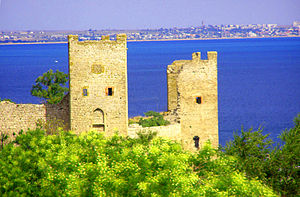| Siege of Caffa | |||||||
|---|---|---|---|---|---|---|---|
| Part of Genoese–Mongol Wars | |||||||
 The remains of a Genoese fortress in Feodosia | |||||||
| |||||||
| Belligerents | |||||||
|
| Golden Horde | ||||||
| Commanders and leaders | |||||||
|
Simone Boccanegra[a] (1345) Giovanni I di Murta[b] (1345–47) | Jani Beg[c] | ||||||
| Strength | |||||||
| Several thousand | Several thousand | ||||||
| Casualties and losses | |||||||
| Several thousand | Several thousand | ||||||
The Siege of Caffa was a 14th-century military encounter when Jani Beg of the Golden Horde sieged the city of Caffa, (today Feodosia) between two periods in the 1340s. The city of Caffa, a Genoese colony, was a vital trading hub located in Crimea. The city was then part of Gazaria, a group of seven ports located in Crimea and belonging to the maritime empire of the Republic of Genoa. The event is historically significant primarily because it is believed to be one of the earliest instances of biological warfare.
The siege of Caffa was characterized by intense military tactics from both sides. After several years of siege, the armies of the Horde were forced to withdraw. The siege is famous for a story recounted by Italian notary Gabriel de Mussis, which attributed the subsequent spread of the Black Death to plague-infested corpses having been launched over the walls at the end of the siege.
Cite error: There are <ref group=lower-alpha> tags or {{efn}} templates on this page, but the references will not show without a {{reflist|group=lower-alpha}} template or {{notelist}} template (see the help page).